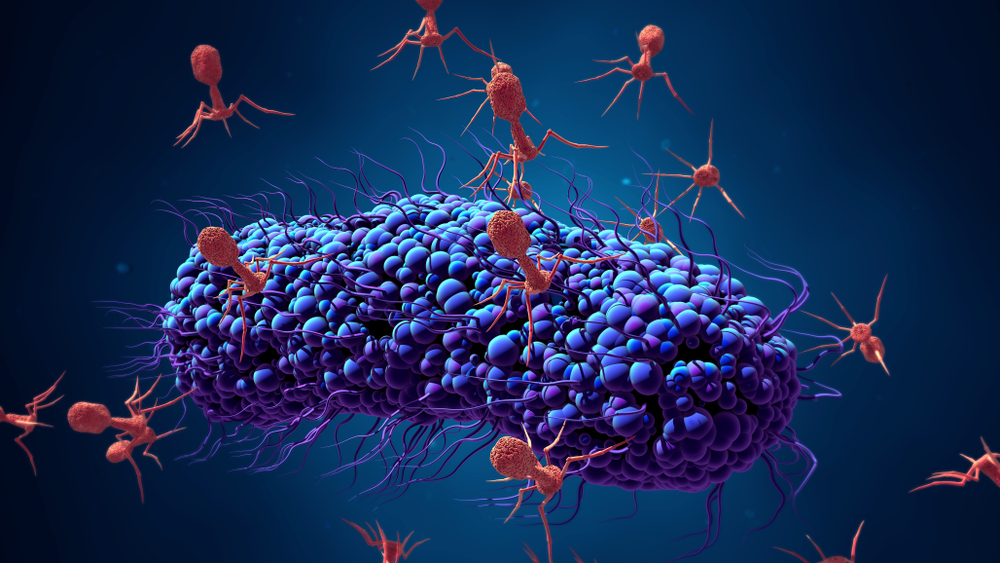The discovery of antibiotics fundamentally changed healthcare in the 20th century. Deadly infections suddenly became treatable and millions of lives were saved. But excessive antibiotic use in both healthcare and agriculture has allowed some microbes to become resistant. Resistance has even been reported to last resort treatments, like colistin, in the past few years. With classic antibiotics failing, will trivial infections become deadly again or will we manage to find new solutions? In this two-part series, we will look into some of the fundamentally different therapeutics that are being developed as alternatives to traditional antibiotics. In this second installment, we highlight bacteriophages: are they finally ready to take center stage, nearly 100 years after being discovered?
For the first article in this two-part series, read Battling Antibiotic resistance: A new protein powered solution.
The promise of phages
Bacteriophages are viruses that specifically infect and kill bacteria. Just like any virus, phages can enter the cell, use the available machinery to reproduce and be set free after cell lysis. While not that well known, they are perhaps the most ubiquitous lifeforms on earth, keeping bacterial populations in check and maintaining important ecological balances even inside the human body.
As phages only target bacterial cells, they leave human cells unharmed. Furthermore, while broad-spectrum antibiotics destroy even beneficial bacteria, phages are highly specific to single strains; they leave the general microbiome intact.
In nature, phages and bacteria are caught in a continuous arms-race to get the upper hand in their battle for survival.
If bacteria develop resistance to a phage, it is less of an issue than antibiotic resistance. Once the mechanism of action of an antibiotic is circumvented, that entire class of compounds becomes obsolete. As phages are living entities, they are capable of co-evolving with their bacterial hosts. In nature, phages and bacteria are caught in a continuous arms-race to get the upper hand in their battle for survival.
Finding their way to the market
Phages were discovered already at the beginning of the 20th century. Though they were quickly applied to both animal and human experiments, because of the extraordinary effectiveness and ease-of-use of broad-spectrum antibiotics, they were largely neglected after World War II. There are exceptions though: in former Soviet states such as Poland or Georgia, bacteriophages have been used in specialized centers since the 1930s. However, due to the methods used in these centers, regulatory bodies elsewhere have yet to accept their evidence of phage efficacy.
So, what is holding bacteriophages back as a valid alternative to antibiotics? Why is their use in combatting antibiotic resistant bacteria not yet widespread?
There are a few inherent drawbacks to bacteriophage therapy. Firstly, their application is limited to the treatment of chronic antibiotic-resistant infections. Because of their high specificity, the bacterial strain causing the infection needs to be determined beforehand, making it impossible to intervene in acute cases. Many aspects of phages also remain understudied. For example, insight into the proteins that phages can produce, including toxins, or their behavior in strictly anaerobic conditions. These issues need to be addressed with fundamental research urgently.
Unlike broad-spectrum antibiotics, phages are not a one-size-fits-all bulk product easy to manufacture and store.
Due to the absence of large-scale phase II or III study results, their efficacy is often also still doubted. Such trials are very costly, meaning phages don’t present an interesting business case for the pharmaceutical industry. Unlike broad-spectrum antibiotics, phages are not a one-size-fits-all bulk product easy to manufacture and store. Because of their specificity, a tailor-made phage cocktail needs to be prepared for each individual patient. This negatively impacts the patentability required to generate income.
Finally, there is no regulatory framework fit for bacteriophages, as they are in the grey zone between chemicals and living cells. Thus, while phages hold a lot of promise, a fresh outlook on the business model and the regulatory aspect is needed to bring them to the patient.
Belgium leads the way with new framework
In Belgium, researchers and governmental institutes have looked for a creative solution to enable the use of bacteriophages in the clinic. This has led to a new national strategy, which will come into effect next month, focused on the use of magistral preparations: medicinal products that are prepared by a pharmacist according to doctor’s prescription, and provide a practical way to make medications available that do not exist commercially.
While bacteriophages have been known about for 100 years, out-of-the-box business models and production have been key to opening the door to much needed clinical trials.
Following this framework, patients will have access to a personalized antibiotic treatment with phage products that complies with strict quality control measures. This is a pioneering approach in the phage therapy field, which is flexible enough to exploit the specific nature of phages while still guaranteeing patient safety. There are indications that this example will be followed by other EU countries in the anticipation of a broader European solution.
The development of phage therapy is a clear demonstration that technical innovations are not all that is needed to bring benefit to a patient. While bacteriophages have been known about for 100 years, out-of-the-box business models and production have been key to opening the door to much needed clinical trials. Here’s hoping, those trials do indeed establish safety and efficacy, so that we gain access to another weapon in our fight against antibiotic resistance.
References:
Vandamme, Erick J., and Kristien Mortelmans. “A century of bacteriophage research and applications: impacts on biotechnology, health, ecology and the economy!.” Journal of Chemical Technology & Biotechnology 94.2 (2019): 323-342.
Pirnay, Jean-Paul, et al. “The magistral phage.” Viruses 10.2 (2018): 64.


